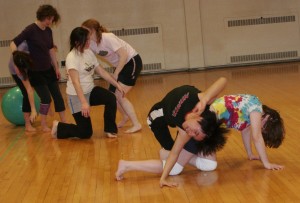
Students participate in a current dance class, Contact Improvisation. Courtesy of Drue Sokol, Photo Editor
If, at this juncture in your Rochester career, your six page resume does not currently reflect your clandestine talents for Capoeira, Bedouin tribal dance, Tai Chi or Anusara Yoga, fret not. In Fall 2011, two new minors — one in Dance and one in Movement Studies — will be made available to all students.
A combined result of efforts on the part of the Dance Department’s new director Missy Pfohl Smith and an increase in student involvement in dance performance groups on campus, the minors will be added to the existing four clusters offered by the department: Dance and Performance, Improvisation and Creative Processes, Mind Body Somatics and Movement and Culture.
They will be awarded to a few graduating seniors this spring due to their extensive previous coursework in the department.
“I have a different vision,” Smith, who has been director of the dance program since Spring 2010 and runs her own dance company, Biodance, in downtown Rochester, explained. “I see dance and dance performance as art forms in a different way than was previously conceived. There are so many dance performance groups on campus that haven’t been involved in formal classes at all, which just doesn’t make sense.”
The dance minor will be comprised of 26 credits from four different realms — Core Context classes, primarily consisting of contemporary dance, jazz, ballet and world dance; Somatic Awareness courses, including yoga, Tai Chi and Chinese Qi Gong; Creative Expression instruction, involving choreography and improvisation; and Styles courses, including a wide variety of two credit explorations into specific branches of dance.
The Movement Studies minor will have the same 26-credit requirement and will also allow students to choose from four areas: Dance Appreciation, Movement Studies, Fundamentals of Movement and core context.
“There’s obviously some overlap since dance is such a big part of movement, but they really are two separate things,” Smith said. “Movement Studies influences the way you approach dance and understand your awareness of the body.”
She added that even though there is structure in the new minors, there is also still room for flexibility and individuality.
“If you’re interested in the Eastern perspective, you can now delve into Tai Chi without having to take ballet and modern, for example, or you can go down the non-Western route and take African dance,” Smith added.
Among a host of new classes to be introduced this fall in order to accommodate the expected influx of students into the department, including new levels of ballet, tap, Middle Eastern dance, Jamaican dance and a Context and Practice Series, are certain upper-level classes that will require auditions for admittance.
“I loved the spirit of openness in not having any audition-based classes, but it also alienated the more experienced dancers and wasn’t working for people in dance groups,” said Smith. “We’re trying to instill new levels while still accommodating beginners.”
Senior Miriam Wertheimer has been a student staff member of the dance department for four years and is leading the promotional campaign of the new minors.
“I think it’s a great opportunity for students to diversify their studies,” Wertheimer said. “For students in pre-med, physical therapy or nursing, this could be a great way to see what the body does, not just on the neurological level but on a practical and physical level — beyond the textbook.”
Although the minors clearly carry an educational component that campus dance groups do not, Smith stressed that, with 300 students formally enrolled in some class in the department and many more involved in these groups, there was a clear need for more communication.
“I think there was a divide, and I feel that now it has been essentially erased,” Smith said.
Senior and President of the Ballet Performance Group (BPG) Kate Canny pointed out that they have been working hard during the past two years to strengthen their ties with the Program of Dance and Movement. BPG has over 80 student members and performs modern, jazz, contemporary and hip-hop dance, in addition to ballet.
“We currently have faculty member Courtney World as one of our ballet instructors and have also been working closely with Director Smith, who has given us valuable feedback and is even choreographing a piece for our spring show,” Canny said.
With more BPG members taking actual dance classes through the program, they hope these relationships will continue growing.
“Even though I’m planning on majoring in Epidemiology, I’ve taken dance classes at UR and am a member of three different dance organizations — BPG, D’Motions and UR Ballroom,” freshman Christina Graham said. “I think the addition of the new minors really says a lot about the breadth of course offerings at UR and I am really happy to see it as an option.”
Buletti is a member of
the class of 2013.





